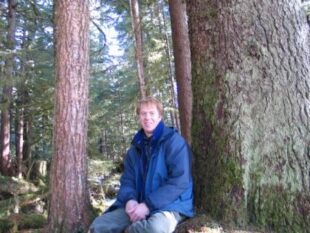Witnessing unethical or illegal behavior in the workplace is among the most challenging of situations for any professional. This is especially true for Forest Service employees, who can find themselves torn between personal integrity and the full weight of a ponderous federal agency.
We understand the challenges of such a dilemma through personal experience and will provide unwavering support to any Forest Service whistleblower who chooses to pursue an ethical path forward. Glen Ith, a Tongass National Forest wildlife biologist, was one Forest Service employee who made such a choice and made a difference, but the cost to Glen cannot be understated.

Glen Ith
In 2005, Glen sent us aerial photographs taken by an Alaska Department of Fish and Game employee. The photos showed ongoing logging road construction to access the Overlook Project area. Overlook was an old-growth forest timber sale in prime winter range habitat for Sitka black-tail deer. What caught Glen’s eye was that the Forest Service had not yet completed the environmental analysis required for the project, but the agency had already started building the roads.
It turns out that Senator Ted Stevens (R-Alaska) had earmarked several million dollars for Tongass roadwork — money that, if not spent by fiscal year’s end, would be lost to the Forest Service, thereby incurring Stevens’ displeasure. The required National Environmental Policy Act reports were behind schedule, but that didn’t stop the Forest Service from moving forward with roadbuilding.
Glen and FSEEE filed suit, challenging the Overlook road construction as well as roadbuilding in Traitors Cove (another site of illegal “advance” work). It was the first-ever environmental lawsuit by a Forest Service employee. We won. The Forest Service retaliated, suspending Glen from work and eliminating his job. Several days later, Glen passed away from sudden heart failure.
Early on in our roads litigation, Glen told us that Tongass officials were using irrational numbers in their deer habitat capability model. He wanted to cure the errors. We agreed the ongoing roads case wasn’t the place to do so, primarily because the issue was not ripe since the timber-sale environmental reviews were not complete.
Glen said he would try to work internally to fix the modeling problem, but he wasn’t confident he would be successful. He believed the errors were intentionally designed to allow the Forest Service to defend logging high-value old-growth forest habitat. Glen assiduously documented the problems with the deer habitat model — documents that Greenpeace’s Larry Edwards later found in the administrative records.
In 2011, in a 3-0 opinion, the Ninth Circuit Court of Appeals ruled that the Forest Service’s use of a deer habitat suitability model was “arbitrary and capricious” because key numbers in the model were altered without any rational explanation. The case is a testament to Glen’s conscientious work and ethics; the persistence of Greenpeace’s Larry Edwards, a Sitka resident; the advocacy skills of co-plaintiff Cascadia Wildlands Project (a grassroots organization with a laudable combination of smarts and passion); and the talents of their legal counsel (Chris Winter of Crag Law Center).
Larry Edwards dedicated the Greenpeace court victory to Glen’s memory.

